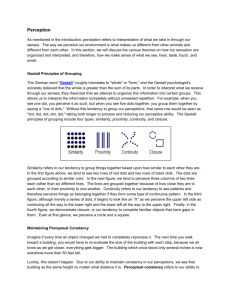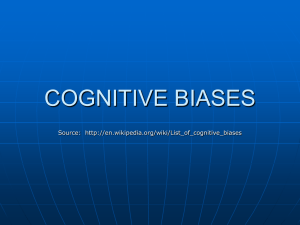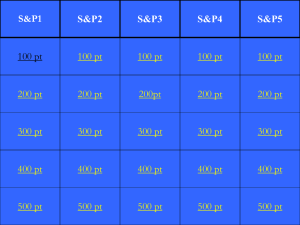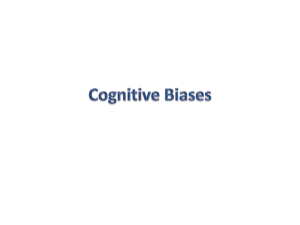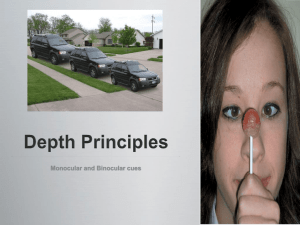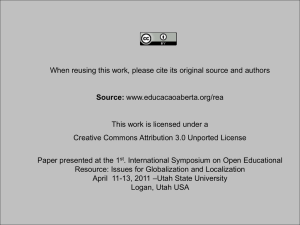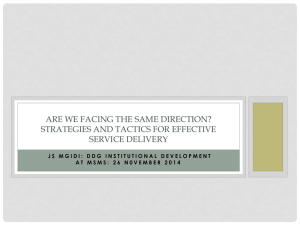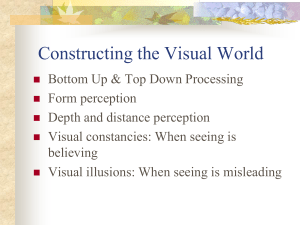PERCEPTION
advertisement
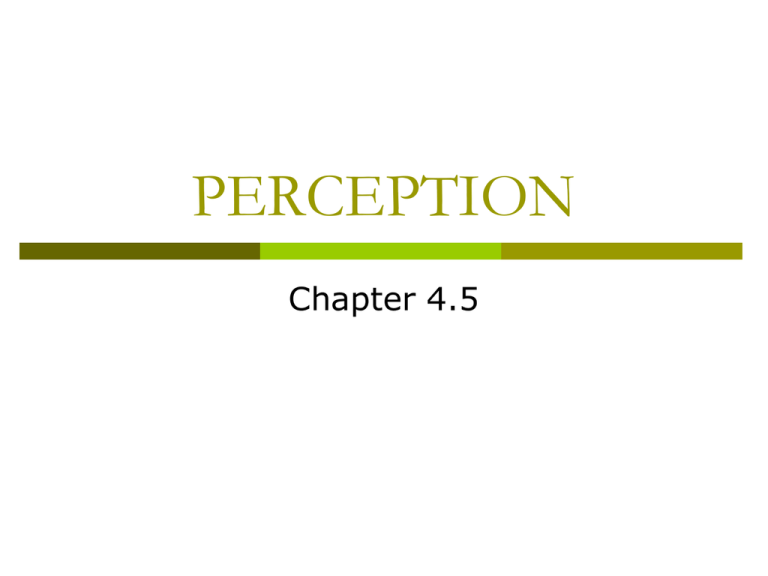
PERCEPTION Chapter 4.5 Gestalt Principles Gestalt principles are based on the idea that the whole is greater than the sum of the parts. These principles allow us to make sense of what we see. 1. Closure: the tendency to perceive a complete or whole figure even when there is part of it missing; there are gaps in what our senses tell us. 2. Figure-Ground Perception: the perception of figures against a background; what you see depends on which you are looking at and it can change as your eyes move from one area to another 3. Proximity: the perceptual tendency to group together visual and auditory events that are near each other; we group things together because they are close to each other 4. Similarity: the perceptual tendency to group things together because they are alike 5. Continuity: the perceptual tendency to group stimuli into continuous patterns 6. Common Fate: the tendency to perceive objects that are moving together as belonging together 7. Law of Good Form – the tendency to organize forms in simplest way possible We see the following figure as a rectangle and a circle instead of one figure with a rounded part on the bottom. 8. Relative size – objects farther away appear to be smaller while objects that are larger appear to be closer 9. Height in plain – distant objects in a picture appear higher while closer objects are lower in the visual field Movement 1. Phi Phenomenon: mistaking apparent movement for the real thing 2. Stroboscopic Motion: the illusion of movement produced by the rapid progression of images or objects that are not moving at all; example: movies Depth Perception This allows us to develop the ability to judge depth or distance away of objects. We perceive this distance by using monocular and binocular cues. There is evidence that depth perception begins to develop early in life. The visual cliff experiment showed this. Very young infants seemed to unafraid when placed on the cliff at the edge of the apparent drop-off. But by nine months, infants responded with fear to the drop-off. Other studies showed that they wouldn’t even cross the “cliff” when called by their mothers. Crawling apparently signaled the need to sense this danger. The only animal that would regularly cross the “cliff” was a rat. This was because they don’t use their vision to sense danger. Their whiskers told them that the surface was still solid so they moved across it. Monocular Cues There are several of these which allow us to judge how close or far away objects are. 1. Linear Perspective: the tendency to see parallel lines as coming closer together, or converging, as they move away from us 2. Interposition (overlap, relative position): the tendency to perceive an object as being closer if it blocks another object 3.Shadows and Highlights: Objects with highlights on their surface and shadows beneath appear to be closer 4. Texture Gradient: the more texture or detail we see in an object, the closer we perceive it to be 5. Motion Parallax: the tendency of objects to seem to move forward or backward depending on how far away they are from the viewer; an example is looking at nearby things out the car window versus objects farther away 6. Atmospheric Perspective: the tendency to perceive hazy or smokey objects as farther away Binocular Cues Both eyes are needed to perceive these cues. 1. Retinal Disparity: binocular cue for perceiving depth based on the difference between two images of an object that the retina receives as the object moves closer; as the object gets closer, the disparity gets greater 2. Convergence: movement of eye muscles that cause pupils to come closer together as an object is brought closer Perceptual Constancies Each person’s experience creates perceptual constancies – constancies of size, color, shape, and brightness. 1. Size Constancy: the tendency to perceive an object as being on one size no matter how far away the object is. 2. Color Constancy: the tendency to perceive objects as keeping their color even though different light might change the appearance of their color 3. Shape Constancy: the tendency to perceive the same shape in an object no matter what angle you view it from 4. Brightness Constancy: the tendency to perceive an object as being equally bright even when the intensity of the light around it changes Optical Illusions This is a false visual perception of a stimulus These are not hallucinations where there is no external stimulus. They exist; we just see them inaccurately. Do you see the word? Seal or Donkey? Old or Young? Are there circles? Old Man or Couple Kissing? Do you see the Dalmation? Do the stairs go up or down? Do you see a man or the word liar?

